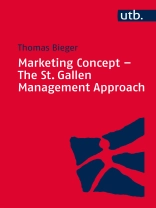This book presents marketing and business processes as an integral part of the St. Gallen Management Model. It provides a tight introduction into the field of marketing and puts the added value in the center of a market-oriented management approach. The book addresses relevant topics such as market analysis, marketing planning, marketing strategy, positioning, application of marketing tools, product design, price, distribution and communication policy, service provision, innovation and controlling processes.
This book aims at students in the first year as well as at practitioners who wants to obtain a quick overview of this field.
สารบัญ
Preface 5
Table of Figures 11
1 Business processes and marketing concept within the St. Gallen Management Model — an introduction 15
1.1 Case study Läderach 15
1.2 Value-creation processes, companies and management 18
1.3 Embedding business processes into the St. Gallen Management Model 23
1.3.1 Stakeholders 25
1.3.2 Environmental spheres 26
1.3.3 Environments and sustainability 28
1.3.4 Horizons of meaning 29
1.3.5 Business processes within the St. Gallen Management Model 30
1.4 Objectives of business processes 32
1.5 Structure of business processes 36
1.5.1 Performance processes 36
1.5.2 Customer processes 38
1.5.3 Innovation processes 41
1.6 The marketing approach for the management of business processes 45
1.6.1 Development of marketing 45
6.1.2 Marketing concept 47
2 Market analysis as the basis for market-oriented business management 49
2.1 Case study Mammut 49
2.2 Customer behavior and markets 51
2.2.1 Definition and role of markets 51
2.2.2 Players and market types 52
2.2.3 Motives, needs, benefit and demand 57
2.3 Market research objectives and data generation 63
2.3.1 Identifying market sizes, needs and decision-making 63
2.3.2 Supply-and-demand trends 67
2.4 SWOT analysis as a synthesis of market analysis 74
3 Marketing strategy — from market segmentation to a positioning strategy
3.1 Case study Jura 77
3.2 Marketing objectives 79
3.2.1 Corporate objectives and marketing objectives 80
3.2.2 Interaction of marketing objectives 82
3.3 From market segmentation to a positioning strategy 84
3.3.1 Segmentation criteria and segmentation level 84
3.3.2 Choice of target market 88
3.3.3 Positioning 89
3.4 From customer processes to tool strategy 90
3.4.1 Determinants of tool application 90
3.4.2 Focus on marketing tool application in the marketing mix 94
4 Product design and performance 97
4.1 Case study Stadler Rail AG 97
4.2 Product design 99
4.3 Performance provision — physical product 105
4.3.1 Basic structure of the performance process 105
4.3.2 Strategic decisions 106
4.3.3 Operational decisions 109
4.4 Performance provision — services 110
4.4.1 Characteristic features of services 111
4.4.2 Performance design and control of the service process 114
4.4.3 From service chain to service blueprint 117
5 Marketing tool application 121
5.1 Case study Jungfraubahn 121
5.2 Pricing policy 123
5.2.1 Neoclassic pricing model 124
5.2.2 Behavioral-science pricing models 126
5.2.3 Functions of pricing 128
5.3 Distribution policy 131
5.3.1 Functions of distribution 132
5.3.2 Distribution design 132
5.4 Communication 135
5.4.1 Role and function of communication 136
5.4.2 Organizational scopes of communication 137
5.4.3 Communication change 139
5.5 Marketing mix 140
5.5.1 Objectives of the marketing mix 140
5.5.2 Planning the marketing mix 141
6 Controlling and innovation 143
6.1 Case study Swiss web portal 143
6.2 Marketing controlling 145
6.2.1 Development of a controlling concept 146
6.2.2 Characteristics of marketing controlling 148
6.2.3 Contribution accounting 149
6.3 Innovation 151
6.3.1 Functions, roles and tools of innovation 151
6.3.2 Return on innovation 152
6.3.3 Innovation in models 154
6.3.4 Innovation’s directions of impact 155
Bibliography 159
Alphabetical index 177
เกี่ยวกับผู้แต่ง
Prof. Dr. Thomas Bieger ist Ordentlicher Universitätsprofessor für Betriebswirtschaftslehre mit besonderer Berücksichtigung der Tourismuswirtschaft an der Universität St. Gallen.












